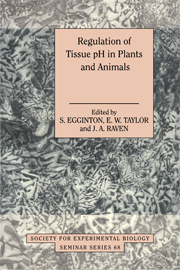Book contents
- Frontmatter
- Contents
- List of contributors
- Preface
- Measurement of intracellular pH: a comparison between ion-sensitive microelectrodes and fluorescent dyes
- pH-sensitive microelectrodes: how to use them in plant cells
- The use of nuclear magnetic resonance for examining pH in living systems
- Invasive studies of intracellular acid–base parameters: quantitative analyses during environmental and functional stress
- Lactate, H+ and ammonia transport and distribution in rainbow trout white muscle after exhaustive exercise
- Limiting factors for acid–base regulation in fish: branchial transfer capacity versus diffusive loss of acid–base relevant ions
- H+-mediated control of ion channels in guard cells of higher plants
- pH regulation of plants with CO2-concentrating mechanisms
- Intracellular pH regulation in plants under anoxia
- The role of turtle shell in acid–base buffering
- Acid–base regulation in crustaceans: the role of bicarbonate ions
- A novel role for the gut of seawater teleosts in acid–base balance
- pH and smooth muscle: regulation and functional effects
- Regulation of pH in vertebrate red blood cells
- Acid–base regulation in hibernation and aestivation
- Hepatic metabolism and pH in starvation and refeeding
- Back to basics: a plea for a fundamental reappraisal of the representation of acidity and basicity in biological solutions
- Index
Regulation of pH in vertebrate red blood cells
Published online by Cambridge University Press: 22 August 2009
- Frontmatter
- Contents
- List of contributors
- Preface
- Measurement of intracellular pH: a comparison between ion-sensitive microelectrodes and fluorescent dyes
- pH-sensitive microelectrodes: how to use them in plant cells
- The use of nuclear magnetic resonance for examining pH in living systems
- Invasive studies of intracellular acid–base parameters: quantitative analyses during environmental and functional stress
- Lactate, H+ and ammonia transport and distribution in rainbow trout white muscle after exhaustive exercise
- Limiting factors for acid–base regulation in fish: branchial transfer capacity versus diffusive loss of acid–base relevant ions
- H+-mediated control of ion channels in guard cells of higher plants
- pH regulation of plants with CO2-concentrating mechanisms
- Intracellular pH regulation in plants under anoxia
- The role of turtle shell in acid–base buffering
- Acid–base regulation in crustaceans: the role of bicarbonate ions
- A novel role for the gut of seawater teleosts in acid–base balance
- pH and smooth muscle: regulation and functional effects
- Regulation of pH in vertebrate red blood cells
- Acid–base regulation in hibernation and aestivation
- Hepatic metabolism and pH in starvation and refeeding
- Back to basics: a plea for a fundamental reappraisal of the representation of acidity and basicity in biological solutions
- Index
Summary
Introduction
Studies examining the regulation of intracellular pH (pHi) in vertebrate red blood cells can be generally divided into two research areas. Because blood is relatively easy to obtain and handle in a laboratory setting, it is an ideal tissue for studies of ion-transport processes in vertebrate membranes. Many investigators have therefore used red blood cells as a model tissue for in vitro studies to elucidate the ion-transport mechanisms involved in pHi regulation in vertebrates. The fact that different phylogenetic groups of vertebrates possess red blood cells with quite different membrane characteristics has led to a proliferation of this research and to the detailed description of a variety of ion-transport mechanisms that are involved in the transport of acid–base equivalents across vertebrate membranes. In contrast, other studies in this area have been oriented towards understanding the functional significance of the factors affecting red blood cell pH in vertebrates. Vertebrate red blood cells have a central role in the transport of O2 and CO2 between the tissues and respiratory surfaces. Since their pH and the carriage of these respiratory gases in blood are intimately related via the Bohr/Haldane and Root effects, the factors determining red blood cell pH in vertebrates have also been intensely studied by respiratory physiologists, whose main goal is to understand the mechanisms involved in the respiratory physiology of different vertebrate groups at both the cellular and organismal levels. Clearly, important insights into the subject of pH regulation in vertebrate red blood cells may be derived from research in each of these areas.
- Type
- Chapter
- Information
- Regulation of Tissue pH in Plants and AnimalsA Reappraisal of Current Techniques, pp. 299 - 322Publisher: Cambridge University PressPrint publication year: 1999

